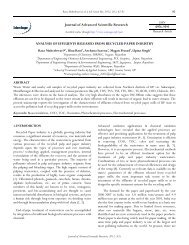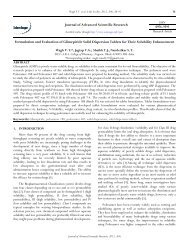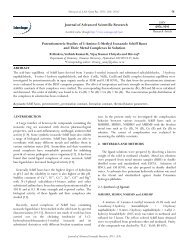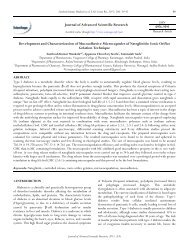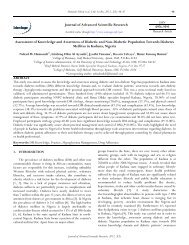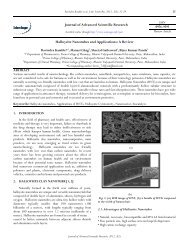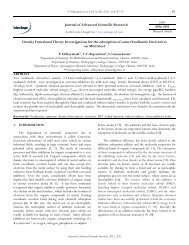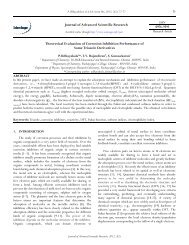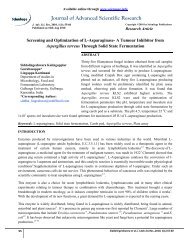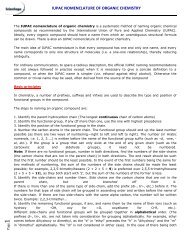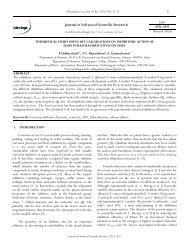Bioassay-Guided Fractionation of the Crude ... - Sciensage.info
Bioassay-Guided Fractionation of the Crude ... - Sciensage.info
Bioassay-Guided Fractionation of the Crude ... - Sciensage.info
Create successful ePaper yourself
Turn your PDF publications into a flip-book with our unique Google optimized e-Paper software.
O.J. Ode et al, J Adv Scient Res, 2011; 2(4): 81-86 81<br />
Journal <strong>of</strong> Advanced Scientific Research<br />
Available online through http://www.sciensage.<strong>info</strong>/jasr<br />
ISSN<br />
0976-9595<br />
Research Article<br />
<strong>Bioassay</strong>-<strong>Guided</strong> <strong>Fractionation</strong> <strong>of</strong> <strong>the</strong> <strong>Crude</strong> Methanol Extract <strong>of</strong> Cassia singueana Leaves<br />
O.J. Ode 1* , I.U. Asuzu 2 , I.E. Ajayi 3<br />
1 Department <strong>of</strong> Veterinary Pharmacology and Toxicology, University <strong>of</strong> Abuja, PMB 117 Abuja, Nigeria.<br />
2 Department <strong>of</strong> Veterinary Physiology and Pharmacology, University <strong>of</strong> Nigeria, Nsukka<br />
3 Department <strong>of</strong> Veterinary Anatomy, University <strong>of</strong> Abuja, Nigeria<br />
*Corresponding Author: juliusode@yahoo.com<br />
ABSTRACT<br />
The crude methanol extract <strong>of</strong> Cassia singueana leaves was subjected to chromatographic separation using column and thin layer<br />
chromatographic techniques. The eluted fractions were screened for bioactivity using indomethacin-induced gastric ulcer model in<br />
rats. The extract yielded eight (8) component fractions. Fraction 8 (F8) exhibited <strong>the</strong> most pr<strong>of</strong>ound anti-ulcer activity when it<br />
completely protected rat stomachs from experimentally-induced ulcerative effects caused by 40 mg/kg <strong>of</strong> oral indomethacin<br />
treatment. Fur<strong>the</strong>r fractionation <strong>of</strong> F8 gave two second generation fractions (A and B). Sub-fraction 8 A or 8 B demonstrated a<br />
comparatively reduced in vivo anti-ulcer protective ability compared to <strong>the</strong> parent fraction (F8). The bioactive effects <strong>of</strong> <strong>the</strong> subfractions<br />
against indomethacin-induced ulcerogenic tendencies in rats appeared to be synergistic.<br />
Keywords: Bioactivity, <strong>Bioassay</strong>, Column chromatography, Thin layer chromatography, <strong>Fractionation</strong><br />
1. INTRODUCTION<br />
Peptic ulcer remains one disease in which multiple drug<br />
<strong>the</strong>rapy is instituted for successful management. Drugs such as<br />
histamine H 2 -receptor antagonists, proton pump inhibitors,<br />
analgesics, broad spectrum antibiotics, antacids and mucosal<br />
resistance enhancers are combined in its treatment [1]. This is<br />
because <strong>the</strong>re is no known drug that proves solely effective in<br />
treating <strong>the</strong> disease. Persistent ulcer relapse compels patients<br />
to undertake intermittent or continuous <strong>the</strong>rapy for many<br />
years [2]. The pathophysiology <strong>of</strong> gastric ulceration is due to an<br />
imbalance between aggressive factors (acid, pepsin,<br />
Helicobacter pylori and non-steroidal anti-inflammatory agents)<br />
and local mucosal defensive factors (mucous bicarbonate, blood<br />
flow and prostaglandins). Peptic ulcer results from overbearing<br />
effects <strong>of</strong> <strong>the</strong> aggressive factors.<br />
Fortunately, <strong>the</strong> plant kingdom has been discovered to<br />
provide alternative sources <strong>of</strong> chemo<strong>the</strong>rapeutic agents. Plant<br />
plays important role in human life as <strong>the</strong> main source <strong>of</strong> food,<br />
medicine, wood, oxygen producer and many more [3]. A large<br />
section <strong>of</strong> <strong>the</strong> world’s population relies on traditional remedies<br />
to treat plethora <strong>of</strong> diseases due to <strong>the</strong>ir low costs, easy access<br />
and reduced side effects [4]. In <strong>the</strong> present decade, <strong>the</strong>re is<br />
rapid development in <strong>the</strong> field <strong>of</strong> medicinal chemistry research,<br />
yet many plant derived drugs cannot be syn<strong>the</strong>tically produced.<br />
Some compounds e.g. atropine and reserpine are too expensive<br />
to be syn<strong>the</strong>sized and <strong>the</strong> possibility <strong>of</strong> syn<strong>the</strong>sizing many o<strong>the</strong>r<br />
useful drugs such as morphine, cocaine, ergometrin remains<br />
vague [5]. Isolation <strong>of</strong> plant derived drugs <strong>the</strong>refore holds<br />
relevance in drug discovery. The use <strong>of</strong> plants as medicine by<br />
human dates back to pre-historic times [6]. Many popular<br />
plant-derived drugs abound e.g. aspirin, an analgesic originated<br />
from Salix alba [7]; atropine, a parasympatholytic drug which<br />
could be used in <strong>the</strong> management <strong>of</strong> severe tetanus [8] is<br />
produced from Atropa belladona; quinine, an anti-malarial drug<br />
came from Chinchona <strong>of</strong>ficinalis and Chinchona pubescens bark [7];<br />
morphine, a potent narcotic analgesic was produced from<br />
Papaver sommniferum [9]; vinblastine and vincristine anti-cancer<br />
drugs originated from catharanthus roseus [10]. <strong>Bioassay</strong>-guided<br />
fraction is a procedure whereby an extract is<br />
chromatographically fractionated and refractionated until a<br />
pure biologically active compound is isolated. Each fraction<br />
produced is evaluated in a bioassay system and only active<br />
fractions are fur<strong>the</strong>r fractionated [11].<br />
Cassia singueana leaves were used in ethnobotanical practice<br />
by <strong>the</strong> Fulani and Hausa tribes <strong>of</strong> Nor<strong>the</strong>rn Nigeria to treat<br />
peptic ulcer cases. The methanol extract <strong>of</strong> <strong>the</strong> plant leaves<br />
demonstrated proven antiulcer activities in different gastric<br />
ulcer induction models [12-14] but <strong>the</strong>re were no prior efforts<br />
at isolating <strong>the</strong> pure compounds responsible for <strong>the</strong> observed<br />
effects. The aim <strong>of</strong> <strong>the</strong> study was to isolate <strong>the</strong> anti-ulcer<br />
fraction(s) in <strong>the</strong> crude extract <strong>of</strong> C. singueana leaves.<br />
Journal <strong>of</strong> Advanced Scientific Research, 2011, 2(4)
O.J. Ode et al, J Adv Scient Res, 2011; 2(4): 81-86 82<br />
2. MATERIAL AND METHODS<br />
2.1. Chemicals, drugs, reagents and instruments<br />
Freshly prepared solutions and analytical grade chemicals<br />
were used for <strong>the</strong> experiments. Concentrated tetraoxosulphate<br />
(VI) acid (H 2 SO 4 ) from BDH laboratories, England;<br />
indomethacin, cimetidine (Sigma Aldrich, USA); methanol was<br />
obtained from Riedel-deHaen, Germany, hexane, chlor<strong>of</strong>orm,<br />
ethylacetate (Sigma Aldrich, USA), vanillin, atomizer,<br />
ultraviolet lamp (Yalien, China), beakers, test tubes and test<br />
tube racks, hot oven (Gallenkamp UK), analytical weighing<br />
balance (Metler), ceramic mortar and pestle, hot plate,<br />
graduated measuring cylinders, thin-layer chromatography<br />
(TLC) tank and TLC plates, silica gel for column and silica gel<br />
for TLC (Sigma Aldrich, USA) were used for <strong>the</strong> study.<br />
2.2. Animals<br />
Matured albino wistar rats <strong>of</strong> both sexes weighing 160-180<br />
g, bred in <strong>the</strong> laboratory animal unit <strong>of</strong> <strong>the</strong> Faculty <strong>of</strong><br />
Pharmaceutical Sciences, University <strong>of</strong> Nigeria, Nsukka were<br />
used for <strong>the</strong> study. The rats were kept in <strong>the</strong> same room with a<br />
temperature varying between 28 and 30 0 C; lighting period was<br />
between 15 and 17 h daily. The rats were kept in stainless steel<br />
wire mesh cages which separated <strong>the</strong>m from <strong>the</strong>ir faeces to<br />
prevent coprophagy. They were supplied clean drinking water<br />
and fed standard animal feed (Grower mash pellets, Vital<br />
feed ® , Nigeria). The laboratory animals were used in<br />
accordance with laboratory practice regulation and <strong>the</strong><br />
principle <strong>of</strong> laboratory animal care as documented by<br />
Zimmerman [15] and NIH [16].<br />
2.3. Preparation and extraction <strong>of</strong> <strong>the</strong> plant material<br />
Fresh leaves <strong>of</strong> C. singueana plant were collected and<br />
au<strong>the</strong>nticated by a taxonomist from Botany department,<br />
University <strong>of</strong> Nigeria, Nsukka. The leaves were dried under<br />
mild sunlight and pulverized into powder in a grinding<br />
machine. Cold extraction was performed using 80% methanol<br />
for 48 h with intermittent shaking at 2 h interval. Removal <strong>of</strong><br />
solvents in vacuo at 40 0 C afforded 11.7% (w/w) <strong>of</strong> methanol<br />
extract. The extract was stored at 4 0 C until used.<br />
2.4. <strong>Fractionation</strong> <strong>of</strong> <strong>the</strong> crude extract <strong>of</strong> C. singueana<br />
leaves<br />
2.4.1. Column chromatography<br />
The crude extract <strong>of</strong> C. singueana (7 g) was subjected to<br />
column chromatography to separate <strong>the</strong> extract into its<br />
component fractions. Silica gel 60G was used as <strong>the</strong> stationary<br />
phase while varying solvent combinations <strong>of</strong> increasing polarity<br />
were used as <strong>the</strong> mobile phase [17]. In <strong>the</strong> setting up <strong>of</strong> column<br />
chromatography, <strong>the</strong> lower part <strong>of</strong> <strong>the</strong> glass column was<br />
stocked with glass wool with <strong>the</strong> aid <strong>of</strong> glass rod. The slurry<br />
prepared by mixing 150 g <strong>of</strong> silica gel and 350 ml <strong>of</strong> hexane<br />
was poured down carefully into <strong>the</strong> column. The tap <strong>of</strong> <strong>the</strong><br />
glass column was left open to allow free flow <strong>of</strong> solvent into a<br />
conical flask below. The set-up was seen to be in order when<br />
<strong>the</strong> solvent drained freely without carrying ei<strong>the</strong>r <strong>the</strong> silica gel<br />
or glass wool into <strong>the</strong> tap. At <strong>the</strong> end <strong>of</strong> <strong>the</strong> packing process,<br />
<strong>the</strong> tap was locked. The column was allowed 24 h to stabilize,<br />
after which, <strong>the</strong> clear solvent on top <strong>of</strong> <strong>the</strong> silica gel was<br />
allowed to drain down to <strong>the</strong> silica gel meniscus. The wet<br />
packing method was used in preparing <strong>the</strong> silica gel column.<br />
The sample was prepared in a ceramic mortar by adsorbing 8.0<br />
g <strong>of</strong> <strong>the</strong> extract to 20 g <strong>of</strong> silica gel 60G in methanol and dried<br />
on a hot plate. Spatula was used to stir <strong>the</strong> sample continuously<br />
to dryness while guarding against getting it burnt. The dry<br />
powder was allowed to cool and <strong>the</strong>n gently layered on top <strong>of</strong><br />
<strong>the</strong> column. The column tap was opened to allow <strong>the</strong> eluent to<br />
flow at <strong>the</strong> rate <strong>of</strong> 40 drops per minute. Elution <strong>of</strong> <strong>the</strong> extract<br />
was done with solvent systems <strong>of</strong> gradually increasing polarity<br />
using hexane, chlor<strong>of</strong>orm, ethylacetate and methanol. The<br />
following ratios <strong>of</strong> solvent combinations were sequentially used<br />
in <strong>the</strong> elution process; Hexane: chlor<strong>of</strong>orm 100:0, 80:20,<br />
60:40, 40: 60, and 20: 80; chlor<strong>of</strong>orm: ethylacetate 100:0,<br />
80:20, 60:40, 40: 60, and 20: 80; ethylacetate: methanol<br />
100:0, 80:20, 60:40, 40: 60, 20: 80 and 0:100. A measured<br />
volume (500 ml) <strong>of</strong> each solvent combination was collected<br />
gradually with a 10 ml syringe and sprayed uniformly by <strong>the</strong><br />
sides <strong>of</strong> <strong>the</strong> glass into <strong>the</strong> column each time. This measure<br />
prevented solvent droplets from falling directly and disturbing<br />
<strong>the</strong> topmost layer <strong>of</strong> <strong>the</strong> column. Distortion <strong>of</strong> this layer would<br />
result in non-uniform drain <strong>of</strong> <strong>the</strong> fractions. The eluted<br />
fractions were collected in aliquots <strong>of</strong> 10 ml in test tubes.<br />
2.4.2. Analytical thin layer chromatography (TLC) and pooling <strong>of</strong><br />
fractions<br />
The content <strong>of</strong> each test tube was spotted on precoated<br />
(silica gel F254) aluminium plates in a small<br />
chromatographic tank to separate <strong>the</strong> different fractions based<br />
on <strong>the</strong>ir relative mobilities in solvent systems and colour<br />
reactions with ultra-violet light. The fractions were<br />
concentrated in a rotovaporator at 40 0 C, and 210 milibar. The<br />
mass <strong>of</strong> <strong>the</strong> different fractions was determined. Analytical TLC<br />
used precoated silica gel (GF254 on polyester plate). A strip <strong>of</strong><br />
<strong>the</strong> precoated silica gel was cut out. With 1.0ʎ micro pipette,<br />
a spot <strong>of</strong> <strong>the</strong> sample was applied on <strong>the</strong> plate about 1.0 cm<br />
from <strong>the</strong> edge. It was dried using hot air dryer. The strip was<br />
lowered into a small chromatographic jar containing <strong>the</strong><br />
solvent system. The jar was covered with a glass lid. The<br />
solvent was allowed to ascend until <strong>the</strong> solvent front was about<br />
¾ <strong>of</strong> <strong>the</strong> length <strong>of</strong> <strong>the</strong> strip. The strip was removed and dried<br />
by a hot air dryer and viewed under UV lamp at 365 and 254<br />
nm to identify <strong>the</strong> fluorescing spot. The fluorescent spot was<br />
marked and <strong>the</strong>n sprayed with spray reagent: 0.16 g vanillin in<br />
30 ml concentrated tetraoxosulphate (IV) acid (H 2 SO4). The<br />
Journal <strong>of</strong> Advanced Scientific Research, 2011, 2(4)
O.J. Ode et al, J Adv Scient Res, 2011; 2(4): 81-86 83<br />
strip was placed in hot oven at 110 0 C for 5 seconds for<br />
visibility <strong>of</strong> fluorescent bands. The colour reaction was<br />
recorded and <strong>the</strong> relative Retention factor (Rf) value was<br />
calculated based on <strong>the</strong> formula described by Stahl [18]:<br />
Rf =<br />
Distance traveled by <strong>the</strong> streak from <strong>the</strong> starting point<br />
Distance traveled by <strong>the</strong> solvent from <strong>the</strong> starting<br />
point to <strong>the</strong> solvent front.<br />
The fractions were kept at 4 0 C in <strong>the</strong> refrigerator for fur<strong>the</strong>r<br />
work.<br />
2.5. In vivo bioassay screening <strong>of</strong> <strong>the</strong> fractions <strong>of</strong> C.<br />
singueana extract using indomethacin-induced gastric<br />
ulcer model in rats<br />
A total <strong>of</strong> 27 albino wister rats <strong>of</strong> both sexes (150-185 g)<br />
were marked, weighed and assigned to 9 groups (A-I) <strong>of</strong> 3 rats<br />
per group. All <strong>the</strong> rats were fasted for 24 h prior to<br />
commencement <strong>of</strong> <strong>the</strong> experiment. Group A (negative<br />
control) was given only distilled water (10 ml/kg) orally,<br />
group B (positive control) received cimetidine (100 mg/kg, per<br />
os), while groups C, D, E, F, G, H, I and J were given oral<br />
treatments with 100 µg/kg <strong>of</strong> <strong>the</strong> corresponding fraction (F).<br />
Group C was given F1, group D received F2, group E was<br />
drenched with F3, group F with F4, group G with F5, group H<br />
with F6, group I with F7 and group J with F8 <strong>of</strong> <strong>the</strong> extract<br />
respectively. After 30 min, each rat was given an oral dose <strong>of</strong><br />
indomethacin (40 mg/kg, p.o.). All treatments were<br />
administered through gastric intubation. The animals were<br />
<strong>the</strong>n allowed 6 h before <strong>the</strong>y were humanely sacrificed by<br />
cervical dislocation. The rat stomachs were carefully removed<br />
and cut open through <strong>the</strong> greater curvature with a scapel blade.<br />
After rinsing with distilled water, each stomach was pinned to<br />
a white background on a wooden board and examined for ulcer<br />
lesions with <strong>the</strong> aid <strong>of</strong> a magnifying lens (x10). Gross<br />
photographs <strong>of</strong> <strong>the</strong> gastric ulcers were taken for<br />
documentation.<br />
2.6. Fur<strong>the</strong>r bioassay-guided fractionation with<br />
Preparative TLC and screening <strong>of</strong> <strong>the</strong> fractions using<br />
indomethacin-induced gastric ulcer model in rats<br />
Preparation <strong>of</strong> plates was done as described by Stahl [18]<br />
with modification. Thirty-five grammes <strong>of</strong> silica gel GF254<br />
(Kieselgel 60 G Merck) was mixed with 85 ml <strong>of</strong> distilled<br />
water in a ceramic mortar and pestle to form slurry. The slurry<br />
was poured into <strong>the</strong> trough <strong>of</strong> a moveable spreader which was<br />
adjusted to 0.5 mm. The slurry was spread in a single passage<br />
onto five glass plates (20 x 20 cm) placed on an improvised<br />
aligning tray. Prior to <strong>the</strong> spreading <strong>of</strong> <strong>the</strong> slurry, <strong>the</strong> surfaces<br />
<strong>of</strong> <strong>the</strong> clean glass plates were made grease-free by cleaning<br />
<strong>the</strong>m with methanol soaked in cotton wool. The freshly coated<br />
chromatographic plates were left on <strong>the</strong> tray until <strong>the</strong><br />
transparency <strong>of</strong> <strong>the</strong> layer disappeared. The plates were<br />
subsequently activated for use in an oven for 1 h at 110 0 C. The<br />
coated surface was marked (using a dissecting pin) on <strong>the</strong><br />
straight edge. A 7 mm margin on both sides <strong>of</strong> <strong>the</strong> plate was<br />
marked and <strong>the</strong> area from <strong>the</strong> edge <strong>of</strong> <strong>the</strong> plate to <strong>the</strong> mark was<br />
not streaked. In <strong>the</strong> application <strong>of</strong> fractions, dropping pipettes<br />
(10 ʎ) were used to apply <strong>the</strong> various pooled fractions on <strong>the</strong><br />
activated plates. Drops <strong>of</strong> <strong>the</strong> pooled fractions were applied in<br />
line to form a straight line streak or band. Each streak was<br />
dried before ano<strong>the</strong>r one was superimposed on it. The streaked<br />
plates were run in a chromatographic tank containing 40 ml<br />
Chlor<strong>of</strong>orm-Ethylacetate-Methanol, 2:2:1 as <strong>the</strong> eluting<br />
solvent. The chromatographic tank was filled to <strong>the</strong> 0.5 cm<br />
mark with <strong>the</strong> eluting solvent. A white blotting paper was<br />
placed on each side <strong>of</strong> <strong>the</strong> tank to saturate <strong>the</strong> tank evenly with<br />
<strong>the</strong> vapour <strong>of</strong> <strong>the</strong> eluting solvent. The tank was immediately<br />
covered after introducing <strong>the</strong> eluting solvent and <strong>the</strong> white<br />
blotting papers. A smear <strong>of</strong> vaseline was applied to <strong>the</strong> edges <strong>of</strong><br />
<strong>the</strong> underside <strong>of</strong> <strong>the</strong> coverlid <strong>of</strong> <strong>the</strong> tank to make sure that <strong>the</strong><br />
lid fitted tightly to avoid escape <strong>of</strong> <strong>the</strong> vapour. The streaked<br />
chromatographic plates were put into <strong>the</strong> tank, two plates at a<br />
time at an angle <strong>of</strong> 30 0 from <strong>the</strong> edge <strong>of</strong> <strong>the</strong> tank. The eluting<br />
solvent was allowed to run for a distance <strong>of</strong> 15 cm starting<br />
from <strong>the</strong> streaked end, after which <strong>the</strong>y were removed from<br />
<strong>the</strong> tank and allowed to dry. The same procedure was carried<br />
out for all o<strong>the</strong>r plates that were subsequently prepared and for<br />
all <strong>the</strong> pooled fractions. Each plate containing a single pooled<br />
fraction was viewed under ultra-violet lamp at 254 and 365 nm<br />
in a dark room. Separated zones were marked and <strong>the</strong> Rf<br />
values were calculated with <strong>the</strong> formula previously described.<br />
Elution <strong>of</strong> separated spot zones: <strong>the</strong> marked separated zones<br />
were scrapped <strong>of</strong>f <strong>the</strong> glass plates with a spatula onto a clean<br />
sheet <strong>of</strong> paper. The scrapings were transferred into centrifuge<br />
tubes containing 5 ml <strong>of</strong> absolute methanol. The content <strong>of</strong> <strong>the</strong><br />
centrifuge tube was shaken manually for 10 mins. The eluent<br />
was separated from <strong>the</strong> adsorbent by centrifuging at 2500 rpm<br />
for 10 mins. This process was repeated until it was satisfactory<br />
that all <strong>the</strong> eluent was collected as much as possible. The<br />
collected eluent in methanol was evaporated to dryness using a<br />
hot air oven at <strong>the</strong> temperature <strong>of</strong> 40 0 C. The eluents were<br />
subjected to fur<strong>the</strong>r bioassay test to confirm biological activity<br />
using indomethacin-induced gastric ulcer model as described<br />
before in 2.5. Eluents that exhibited maximal in vivo stomach<br />
ulcer protective ability were <strong>the</strong>n labeled as <strong>the</strong> active<br />
fractions.<br />
3. RESULTS<br />
3.1. <strong>Fractionation</strong> <strong>of</strong> <strong>the</strong> crude extract <strong>of</strong> C. singueana<br />
leaves<br />
A total <strong>of</strong> eight (8) preliminary fractions <strong>of</strong> C. singueana<br />
extract were eluted and identified. The fluorescent<br />
characteristics <strong>of</strong> <strong>the</strong> fractions including <strong>the</strong>ir Rf values and<br />
wavelengths are presented in Table 1.<br />
Journal <strong>of</strong> Advanced Scientific Research, 2011, 2(4)
O.J. Ode et al, J Adv Scient Res, 2011; 2(4): 81-86 84<br />
Table 1: Characteristics <strong>of</strong> fractions from <strong>the</strong> extract <strong>of</strong> Cassia singueana leaves<br />
Fractions Quantity Spots TLC coloration<br />
(mg) (RF) UV 254 nm 356 nm<br />
F1 1.14 0.667 grey Absorbed<br />
F2 0.19 0.400 yellowish brown Absorbed<br />
F3 0.59 0.511 pink Absorbed<br />
F4 0.28 0.410 light yellow Absorbed<br />
F5 0.91 0.267 brown Absorbed<br />
F6 1.24 0.622 orange Absorbed<br />
F7 0.87 0.429 reddish brown Absorbed<br />
F8 0.211 0.824 dark brown Absorbed<br />
Eluent: chlor<strong>of</strong>orm - ethylacetate - methanol (3:2:1)<br />
3.2. In vivo bioassay screening <strong>of</strong> <strong>the</strong> fractions <strong>of</strong> C.<br />
singueana extract using indomethacin-induced gastric<br />
ulcer model in rats<br />
Group A (negative control): The rats were given only<br />
distilled water prior to gastric ulcer induction with<br />
indomethacin (40 mg/kg, p.o.). There were severe ulcerations<br />
in <strong>the</strong> gastric mucosa (Plate 1).<br />
with indomethacin treatment. The rat stomachs were<br />
completely protected from ulceration (Plate 3).<br />
Group B (positive control): The rats received cimetidine<br />
(100 mg/kg, p.o.), a reference antiulcer drug, before stomach<br />
ulcers were induced with indomethacin (40 mg/kg, p.o.). The<br />
stomach epi<strong>the</strong>lia <strong>of</strong> <strong>the</strong> rats were visibly protected and only a<br />
few (2 in number) focal ulcer lesions could be seen in one <strong>of</strong><br />
<strong>the</strong> stomachs (Plate 2).<br />
Plate 2: Gross appearance <strong>of</strong> cimetidine-protected rat stomachs with<br />
minimal focal ulcer lesions from indomethacin ulcer induction.<br />
Plate 1: Gross photograph <strong>of</strong> rat stomachs from negative control<br />
showing deep and severe ulcer lesions in indomethacin (40 mg/kg)<br />
ulcer induction.<br />
Groups C-I: Rats in <strong>the</strong> separate groups were given oral<br />
treatment (100 µg/kg) <strong>of</strong> one out <strong>of</strong> <strong>the</strong> first seven fractions<br />
(F 1 -F 7 ) <strong>of</strong> C. singueana extract respectively, before gastric ulcer<br />
induction with indomethacin (40 mg/kg, p.o.). Severe gastric<br />
ulcer lesions comparable to <strong>the</strong> ones in <strong>the</strong> negative control<br />
rats (Plate 1) were produced.<br />
Group J: Each rat in this group was given 100 µg/kg <strong>of</strong> <strong>the</strong><br />
last fraction (F8) <strong>of</strong> <strong>the</strong> extract prior to gastric ulcer induction<br />
Plate 3: Stomachs from rats treated with F 8 showing complete<br />
protection against <strong>the</strong> ulcerative effects <strong>of</strong> indomethacin (40 mg/kg).<br />
3.3. Fur<strong>the</strong>r bioassay-guided fractionation with<br />
Preparative TLC and screening <strong>of</strong> <strong>the</strong> fractions using<br />
indomethacin-induced gastric ulcer model in rats<br />
Fraction 8 (F8) became <strong>the</strong> most bioactive component<br />
<strong>of</strong> C. singueana extract against indomethacin-induced gastric<br />
ulceration in rats and fur<strong>the</strong>r fractionation <strong>of</strong> it using TLC<br />
yielded two sub-fractions, A and B (Plate 4). Sub-fraction 8 A<br />
had Rf value <strong>of</strong> 0.235 while that <strong>of</strong> sub-fraction 8 B was 0.824.<br />
Fur<strong>the</strong>r in vivo tests with <strong>the</strong> sub-fractions (8 A and 8 B ) using<br />
indomethacin-induced gastric model revealed that each sub-<br />
Journal <strong>of</strong> Advanced Scientific Research, 2011, 2(4)
O.J. Ode et al, J Adv Scient Res, 2011; 2(4): 81-86 85<br />
fraction had a reduced protective ability against <strong>the</strong> ulcerative<br />
tendencies <strong>of</strong> indomethacin treatment compared to <strong>the</strong> parent<br />
fraction (F8).<br />
F8 8 A 8 B <strong>Crude</strong><br />
Eluent: chlor<strong>of</strong>orm and methanol (2:2)<br />
4. DISCUSSION<br />
The crude extract <strong>of</strong> C. singueana leaves yielded 8 distinct<br />
fractions on column chromatography. Fraction 8 became <strong>the</strong><br />
most bioactive component <strong>of</strong> <strong>the</strong> extract when it completely<br />
protected rat stomachs from experimentally-induced ulcerative<br />
lesions caused by 40 mg/kg <strong>of</strong> indomethacin treatment.<br />
Indomethacin, a non-steroidal anti-inflammatory drug (NSAID),<br />
inhibits cyclooxygenase conversion <strong>of</strong> arachidonic acid from cell<br />
membrane phospholipids to prostaglandins and thromboxanes.<br />
Prostaglandins induce inflammation but <strong>the</strong>y are also needed for<br />
maintenance <strong>of</strong> <strong>the</strong> integrity <strong>of</strong> gastro-intestinal (GI) epi<strong>the</strong>lium.<br />
NSAIDs cause prostaglandin cyto-protective deficiency which<br />
contributes to <strong>the</strong> pathogenesis <strong>of</strong> gastric injuries [19].<br />
Cyclooxygenase I (COX-I) is a constitutive enzyme and its<br />
secretions are valuable for tissue homeostasis; its inhibition gives<br />
rise to GI ulceration [20]. Cyclooxygenase II (COX-2)<br />
expression on <strong>the</strong> o<strong>the</strong>r hand, is triggered <strong>of</strong>f by an<br />
inflammatory process; hence selective inhibition <strong>of</strong> COX-2<br />
represents selective inhibition <strong>of</strong> prostaglandin biosyn<strong>the</strong>sis<br />
during inflammation [9]. NSAIDs including indomethacin<br />
suppress both COX-I and COX-II resulting in stomach ulcers.<br />
The effect <strong>of</strong> indomethacin on COX-1 enzyme was most likely<br />
blocked by <strong>the</strong> extract but <strong>the</strong> mechanism is not yet fully<br />
understood. Minimal ulcer lesions were produced in <strong>the</strong><br />
stomach <strong>of</strong> rats that were pre-treated with 100 mg/kg <strong>of</strong><br />
cimetidine, a popular anti-ulcer drug but <strong>the</strong>re was no<br />
ulceration in <strong>the</strong> stomach <strong>of</strong> fraction 8-treated rats (Plate 3).<br />
This showed that F8 was more potent against indomethacininduced<br />
ulcerogenesis compared to cimetidine. Fur<strong>the</strong>r<br />
fractionation <strong>of</strong> F8 gave two sub-fractions (8 A and 8 B ) which had<br />
reduced gastro-protective effects against toxic injury caused by<br />
indomethacin in <strong>the</strong> experimental rats. The anti-ulcer effects <strong>of</strong><br />
sub-fractions 8 A and 8 B could <strong>the</strong>refore be synergistic. <strong>Bioassay</strong>guided<br />
fractionation is a procedure whereby an extract is<br />
chromatographically fractionated and refractionated until pure<br />
biologically active compound is isolated. Bioactive compound<br />
can <strong>the</strong>n be isolated through fur<strong>the</strong>r preparative TLC. TLC is a<br />
basic method suitable for rapid detection <strong>of</strong> drug substances. It<br />
is a method for separating individual components comprising a<br />
sample by using thin layer <strong>of</strong> silica gel as a stationary phase [18].<br />
TLC technique is advantageous in that it is selective, specific and<br />
rapid in identifying drug substances than <strong>the</strong> simple<br />
characterisation methods using chemical reagents which reveal<br />
substances by colour and precipitation reaction tests [21].<br />
Chemical tests should however, complement TLC findings.<br />
There is no interference by excipients in TLC and <strong>the</strong> method<br />
can be used for identification, purity test and semi-quantitative<br />
estimation <strong>of</strong> <strong>the</strong> active ingredient in <strong>the</strong> dosage forms [22].<br />
Each fraction produced was evaluated in an in vivo bioassay<br />
system using rats to facilitate selection <strong>of</strong> <strong>the</strong> bioactive fraction.<br />
The bioactive fraction would usually produce <strong>the</strong> desired<br />
biological activity which in this case, is inhibition <strong>of</strong><br />
indomethacin-induced gastric ulceration in <strong>the</strong> experimental<br />
rats. Degradation or transformation <strong>of</strong> <strong>the</strong> active plant<br />
constituent may occur during fractionation due to hydrolysis,<br />
esterification, oxygenation or ultraviolet irradiation [21]. Again,<br />
decrease in activity after fractionation may be as a result <strong>of</strong> <strong>the</strong><br />
phenomenon <strong>of</strong> synergy between <strong>the</strong> active ingredients.<br />
5. CONCLUSION<br />
Fraction 8 with Rf 0.824 from <strong>the</strong> crude methanol extract<br />
<strong>of</strong> C. singueana leaves was isolated as <strong>the</strong> most pr<strong>of</strong>ound<br />
bioactive anti-ulcer agent in <strong>the</strong> plant leaves. It exhibited greater<br />
potency compared to cimetidine in experimentally-induced<br />
toxic assault from indomethacin in rats.<br />
6. REFERENCES<br />
1. Schneeweiss S, Maclure M, Dormuth CR, Glynn RJ, Canning C,<br />
Avorn J. Clinical Pharmacology & Therapeutics, 2006; 79(4): 379-<br />
386.<br />
2. Munson PL, Mueller RA, Breese GR. Principles <strong>of</strong><br />
pharmacology: Basic concepts and clinical applications. Chapman<br />
& Hall, USA: 1995; 1063-1081.<br />
3. Cowan MM. Clin Microbiol Rev, 1999; 12 (4): 564-582.<br />
4. Marino-Betlolo GB, J. Ethnopharmacol, 1980; 2: 5-7.<br />
5. Atta-ur-Rahman. Natural product chemistry. Springer-verlag,<br />
Heidelberg, Germany. 1986; 1-120.<br />
6. Berhanemeskel W. African Journal <strong>of</strong> Pharmacy and Pharmaology,<br />
2009; 3(9): 400-403.<br />
7. Di PALMA JR. Drill’s Pharmacology in medicine, 4 th ed.<br />
McGraw-Hill Book, London: 1971; 379, 1770-1773.<br />
8. Dollar D. Intensive care Medicine, 1991; 18(1): 26-31.<br />
9. Rang HP, Dale MM, Ritter JM, Moore PK. Pharmacology, 5 th<br />
ed. Churchill Livingstone, London: 2003; 572-584.<br />
10. Cynthia RL. Clinical Pharmacology. Teton Newmedia, USA:<br />
2001; 97.<br />
11. Atta-ur-Rahman, Quesne Le P. Eds. Natural products chemistry,<br />
Springer-verlag, Berlin. 1988: 150-450.<br />
12. Ode OJ. Journal <strong>of</strong> Advanced Scientific Research, 2011; 2(3): 66-69.<br />
13. Ode OJ, Asuzu OV. International Journal <strong>of</strong> Plant, Animal and<br />
Environmental Sciences, 2011; 1(1): 1-7.<br />
Journal <strong>of</strong> Advanced Scientific Research, 2011, 2(4)
O.J. Ode et al, J Adv Scient Res, 2011; 2(4): 81-86 86<br />
14. Ode OJ, Oladele GM, Asuzu OV. International Journal <strong>of</strong> Plant,<br />
Animal and Environmental Sciences, 2011; 1(1): 54-60.<br />
15. Zimmermann M. Pain, 1983; 16(2): 109-110.<br />
16. National Institute <strong>of</strong> Health (NIH)<br />
http://www.niehs.nih.gov/oc/factsheets/wrl/studybgn.html<br />
17. Abbot D, Andrews RS. An Introduction to chromatography 2 nd<br />
ed. Longman press, London: 1970; 72-78.<br />
18. Stahl E. Thin layer chromatography: A laboratory handbook.<br />
Springerverlag, Berlin-Herdberg, New York: 1969; 60-204.<br />
19. Takeuchi K, Niida H, Ohuchi T, Okabe S. Digestive Diseases &<br />
Sciences, 1994; 39: 2536-2542.<br />
20. McNamara DB, Mayeux PR. Nonopiate Analgesics and Antiinflammatory<br />
drugs In: Munson, PL, Mueller RA, Breese GR.<br />
(Eds.) Principles <strong>of</strong> Pharmacology: Basic concepts and clinical<br />
applications. Chapman & Hall, USA: 1995; 1162.<br />
21. Bakshi B, Singh S. Journal <strong>of</strong> Pharmaceutical and Biomedical Analysis,<br />
2002; 28: 1011-1040.<br />
22. World Health organization publication on basic tests for drugs:<br />
pharmaceutical substances, medicinal plant materials and dosage<br />
forms, 1988.<br />
Journal <strong>of</strong> Advanced Scientific Research, 2011, 2(4)



